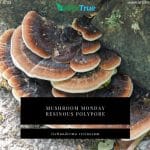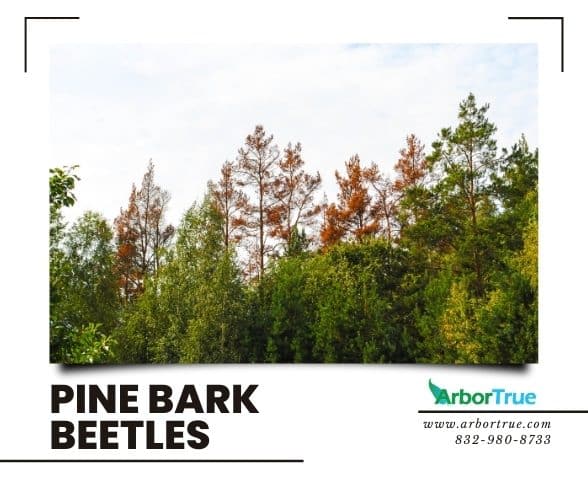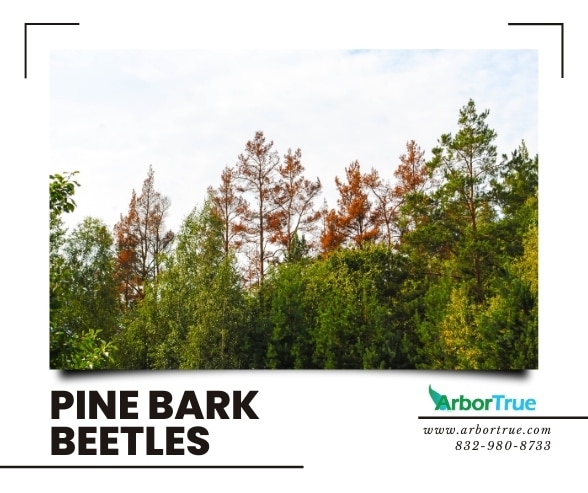
Mushroom Monday: Resinous Polypore (Ischnoderma resinosum)
April 15, 2024
Blue Stain Fungi
April 19, 2024
Pine Bark Beetles
Recently, we shared some information with you about treatment for pine bark beetles. In today’s post, we’ll go a little more in depth about the beetles themselves, so you can have a better understanding of them and so you can be more aware should you have a problem and need the help of an arborist. Not that long ago, we had three videos about pine bark beetles on our Facebook page. Check them out to learn more. You can find them here: Pine Bark Beetles Video One, Pine Bark Beetles Video Two, Pine Bark Beetles Video Three.
What are Pine Bark Beetles?
Pine bark beetles are beetles that attack pine trees. There are three main types. They are the southern pine beetle, the Ips engraver beetle (there are three kinds of these), and the black turpentine beetle. Although there are a number of differences between these beetles, they have a lot of similarities and they can damage and kill pine trees.
A Basic Overview of the Three Types of Pine Bark Beetle
Southern Pine Beetle
Scientific name: Dendroctonus frontalis
Size: About the size of a grain of rice
Appearance: red/brown or black in color with a round backside
Common in the southeast Texas area: No
Health of trees it attacks: Healthy and stressed trees
Amount of time it takes a tree to die after infection: As little as two weeks
Shape of galleries it makes in trees: S-shaped
Ips Engraver Beetle
Scientific name: Ips spp.
Size: About the size of a grain of rice
Appearance: Has spines on its scooped backside
Common in the southeast Texas area: Yes
Health of trees it attacks: Stressed trees
Amount of time it takes a tree to die after infection: As little as two weeks
Variations: four, five, and six-spined – this refers to the number of spines on the beetle’s backside
Parts of tree they generally attack:
Four-spined: branches
Five-spined: trunk within branch region
Six-spined: larger areas of trunk (can overlap with five-spined region)
Shape of galleries it makes in trees: I, Y, X, or H in shape
Black Turpentine Beetle
Scientific name: Dendroctonus terebrans
Size: About the size of three grains of rice
Appearance: black or brown when adults and with a round backside.
Common in the southeast Texas area: Yes
Health of trees it attacks: Stressed trees
Amount of time it takes a tree to die after infection: Can take years to kill a tree
Parts of tree they generally attack: terpene-rich areas (bottom ten feet of trunk) – they generally don’t go above ten feet
Shape of galleries: meandering and large. Can be filled with a sticky material.
How do Pine Bark Beetles Damage Trees?
Pine bark beetles damage trees in a number of ways. For instance, they bore through the bark of the tree when they enter, they make tunnels in a tree when they eat and to lay their eggs, which can stop water and nutrients from flowing, and they make holes when they exit a tree. When they stop water and nutrients from flowing in a tree, the tree can die. They can also introduce a blue stain fungus to trees that can prevent water from flowing in the tree.
Why Do Pine Bark Beetles Attack Stressed Trees?
Stressed trees are more susceptible to attacks from pine bark beetles for different reasons.
One reason is that stressed trees release hormones. One of these hormones is a gas called ethylene. This gas leaves a stressed tree (along with terpenes) and the beetles can smell it and are attracted to the scent.
A second reason is that a stressed tree is less able to defend itself from attack than a healthy tree. A healthy pine tree can have a lot of sap. When a beetle bores into it, the tree will flood the area with sap, capture the beetle, and kill it. A stressed tree produces less sap. When a beetle bores into it, it can survive, attract other beetles by releasing pheromones, mate, lay eggs, and infest the tree.
One main cause of stress that can cause an increase in pine bark beetle numbers is drought. Drought can weaken pine trees and leave them more susceptible to attack. Other causes of stress include too many trees too close together, damage from storms, fire, and lightning, stress from chemicals such as weed and feed products, and stress from machines such as mowers.
What are Some Signs a Tree Has Pine Bark Beetles?
The signs can vary depending on which beetle a tree is infested with, the health of the tree, and the level of infestation.
Some signs can include:
The beetles themselves – black turpentine beetles are the largest and most easiest to see
Beetle larvae
Bark can fall off
Galleries (tunnels) can be seen under the bark after the tree dies or if the bark is off
Holes in fallen branches (from the Ips four-spined beetles)
Needles can change color – they can lighten from green to yellow and then become red
Pitch tubes (dried sap) can be seen on the entry points of the beetle – this might not been in stressed trees that can’t produce sufficient sap
Sawdust from holes
Holes where the beetles entered the tree
Large number of small pine cones being produced (a sign the tree is stressed)
Can Pine Bark Beetle Infestations be Prevented or Treated?
This depends on the beetle, the health of the trees, the environmental conditions, and the severity of infestation.
A healthy tree is less susceptible to pine bark beetles than a stressed one, so keeping your trees healthy is a good first step. An arborist can inspect your trees and help you develop a plan for their care.
Pine bark beetles can be prevented and treated in some cases. An arborist can examine your trees to tell you what can be done. There is a treatment method available that can be appropriate in some cases.
In some cases infected trees can be removed to prevent the spread to other trees.
Since black turpentine beetles are more noticeable and they take longer to kill a tree, they can be treated more easily than the other types of pine bark beetles.
In some cases, pine bark beetle infestations can’t be treated. If a tree is infected, it can sometimes die in a matter of weeks. This is why keeping trees healthy and working on prevention are important.
If you think you might have pine bark beetles or are interested in trying to prevent them, contact us to arrange for an appointment. An arborist can let you know what could be right for your situation. If you found this helpful, check out our other posts on our TrueTreeTalk blog. Follow us on Facebook to keep up with these and other posts. Check out our list of blog posts grouped by topic for more to read. Also, follow us on LinkedIn for industry-related posts.
* * *
ArborTrue is a science-based tree service company in the greater Houston area. We also serve Austin and other parts of Central Texas. We provide a range of services including tree trimming, tree pruning, tree removal, tree planting, arborist consultations, and more. Call us today at 832-980-8733 (Houston) or at 512-546-3833 (Austin) or reach out to us online to schedule an appointment.
ArborTrue has a dedicated landscaping division, now serving select areas in the greater Houston region—with more locations coming soon. We specialize in organic practices, soil biology, and ecological health to help your entire landscape truly thrive. To learn more or schedule a consultation, contact us at landscape@arbortrue.com.




